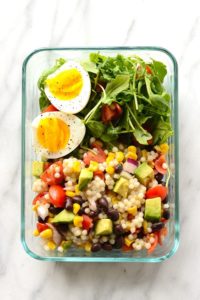Nutritional Rules Everyone Should Know.
Whether you are an athlete, or working on a goal for losing weight or possibly maintaining your weight it is important to know how much of fat, carbs, and protein to consume each day for body health reasons. Splitting up your food consumption, 18% should be from healthy fats, 27% for lean protein and 55% of complex carbs. Now complex carbs doesn’t mean 50% of your daily value should be pastas breads, in other words starchy foods, but breaking that 55% to 35% of that should be greens/vegetables and 20% should be starches. Here is a bit better break down of what you should consume for each group.
Healthy Fats:
2-3 Servings
18% of your daily intake of food should come from healthy fats such as fish, nuts, seeds, and healthy oils. Flaxseeds and fish contain omega-3 fats. Omega-6 fats can be found in sunflower, saufflower, corn, black current, borage and evening primrose oils, soybean oils, meat and dairy products from grass fed animals.
Examples- Almonds, cold water fish, nut butters, pumpkin seed oils, walnuts, avocados, flaxseed, olive oil, saufflower, cashews, hazelnut oil, pecans, sunflower seeds
Lean Proteins:
6 Servings
Protein is primarily found in meats, poultry, fish and eggs but it is also found in dairy  and to some degree in vegetable and grain sources. Tofu, chia seeds, quinoa, and hemp seeds are complete proteins. other plant sources must be eaten in combination in order to be complete.
and to some degree in vegetable and grain sources. Tofu, chia seeds, quinoa, and hemp seeds are complete proteins. other plant sources must be eaten in combination in order to be complete.
Examples- almond butter, beef tenderloin, canned tuna, chickpeas, fresh cod, ground turkey, cottage cheese, rice milk, tofu, bison, cashew butter, eggs, fresh salmon, kefir, peanut butter, soy milk, unsalted nuts, beans, chicken, fat-free yogurt, fresh tilapia, lentils, tempeh, and pork tenderloin.
Complex Carbohydrates:
2-4 Servings Starch and 4-6 Servings Vegetables
There are two types of carbohydrates, simple and complex. Simple carbohydrates (think of white flour and sugar) are also known as sugars. they break down easily and tend to send blood sugar levels out of control. For the most part, you want to avoid simple carbs with fruit as the exception. Fruits are simple carbs but they also contian fiber, which slows down their digestion as well as vital nutrients and vitamins.
Complex carbohydrates are high in fiber and improve digestion. They provide you with energy, keep you satisfied after meals and stabilize blood sugar levels. Vegetables, fruits and whole grains are complex carbohydrates.
Examples of starchy complex carbs from whole grains- Cream of wheat, wheat germ, brown rice, millet, whole-grain pasta, buckwheat, oatmeal, bulgur, and quinoa.
Examples of starchy carbs from vegetable sources- Bananas, chickpeas, split peas, beans, sweet potatoes, yams, lentils, carrots and radishes.
Examples of high water content complex carbs- Artichokes, cucumbers, onions, eggplant, cabbage, asparagus, watercess, beet greens, cauliflower, kale, spinach, zucchini, broccoli, lettuce, celery and tomatoes.
If you’d like to better your caloric intake and have nutritional guidance, our personal trainers are well informed and certified to better help your needs! Stop on by!
Eat Clean. Stay Morefit.
